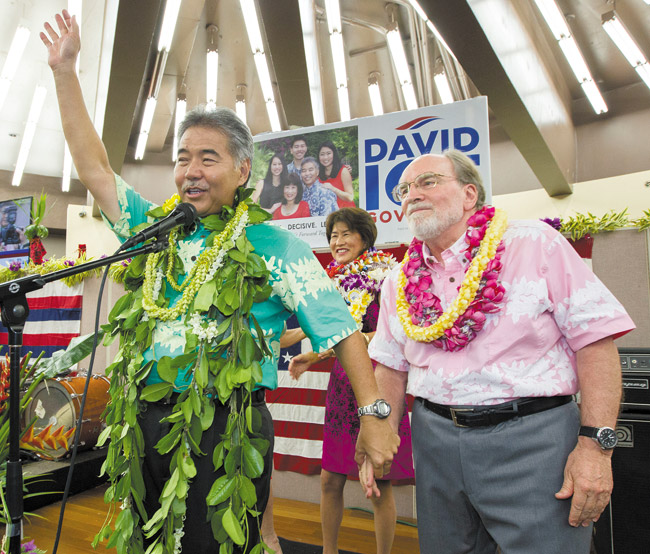Neil’s Bullying, Blustering Led To Loss

State Sen. David Ige (left) waves to his supporters and thanks Gov. Neil Abercrombie Aug. 9 after Ige defeated the governor in the primary election. AP PHOTO/EUGENE TANNER
Four years ago, Neil Abercrombie resigned a safe seat in the United States Congress to run for governor. He easily defeated his Democratic primary opponent Mufi Hannemann. In the November general election, he just as easily dispatched Republican gubernatorial nominee Duke Aiona.
Four short years later, Abercrombie became the first sitting governor in Hawaii’s history to lose in a primary election.
And it wasn’t pretty. When the final votes were counted, Abercrombie carried only three of the state’s 51 House districts, losing to his opponent by better than a 2-to-1 margin. A quiet, little-known, underfunded state senator, David Ige, beat Abercrombie damned near everywhere, this despite being outspent by the incumbent governor 10-to-1.
How can?
Easy. Real easy. By Neil being Neil in Hawaii every day for four long years.
Go back to 1970. In that year, Abercrombie entered Hawaii politics as a long-haired, colorfully attired candidate for U.S. Senate. He didn’t come close to winning, but the press loved him. He’s endlessly quotable, and Abercrombie received a disproportionate amount of ink, if few votes.
In 1974, he won the Manoa seat in the state House of Representatives; four years later, he moved to state Senate. He served in the Legislature for a dozen years, providing sound bites by the bushel for print and television reporters alike. His reputation grew, but he also began to grate. Reporters began to flee Abercrombie’s torrent of words.
Perhaps some voters did as well. In 1986, Rep. Cec Heftel resigned his seat to run for governor. Abercrombie won a multi-candidate race to serve out the remaining months of Heftel’s term. But he lost the Democratic primary for the full term to Hannemann, who in turn lost the general election to Republican Pat Saiki.
Abercrombie found a place to park at the Department of Education, but not for long. In 1988 he won an open seat on the Honolulu City Council. Two years into his term, Saiki announced for the Senate. Abercrombie, Senate president Norman Mizuguchi and Matt Matsunaga ran for the vacant House seat.
The latter two split the local vote, and Neil Abercrombie went back to Washington, this time for 20 years.
He was out of sight and out of mind. Neither daily newspaper of the day maintained a Washington bureau. Neither did any of the television stations. Neil’s rhetorical flourishes and pitch-perfect sound bites seldom went anywhere but into the dull, gray Congressional Record.
When he did return to Hawaii during congressional recesses, Abercrombie’s volubility was restricted to Rotary Club speeches few attended, public television shows few watched, or Democratic state party conventions full of only the faithful.
But then he came home for good, to become governor in the midst of the Great Recession. He brought with him a “New Day Plan” full of promises that the state’s treasury and the Legislature’s reticence about raising taxes could not keep.
Worse, everyone listened to every word Gov. Abercrombie said, whether dressing down nurses, proposing to tax the pensions of retirees, suggesting Dan Inouye didn’t ask him to appoint Colleen Hanabusa to the Senate, calling for a special session to pass a same-sex marriage bill, or telling Hawaii’s teachers that this was the state’s “last and best offer.”
And Abercrombie’s torrent of words, his “bullying and bluster,” as one critic put it, wore thin very fast.
Ultimately, the voters grew weary, two-thirds of them.
dbboylan@yahoo.com





